- A Climate Suitability Analysis for Western Hemlock: Modeling Future Occurrence Probability of Tsuga heterophylla at the UBC Vancouver Campus
To better manage green spaces in the face of climate change, the Social Ecological Economic Development Studies program of the University of British Columbia (UBC) organized a series of projects to predict the climate suitability of common tree species at Vancouver campus by 2100. Coniferous trees are vulnerable to changing precipitation and temperature. Western hemlock (Tsuga heterophylla) is a common coniferous tree species at UBC Vancouver campus and was chosen to be analyzed in this study. Climate suitability analysis was done using a MaxEnt model. As a machine-learning algorithm not requiring data about absent points, MaxEnt is considered to be a good tool for predicting the distribution of species. There were 19 bioclimatic variables tested in the analysis, and the precipitation in the coldest quarter of the year was determined to be the most important climatic variable affecting the growth of Western hemlock. The results showed that the occurrence probability of Western hemlock would drop from its current ~87% to ~10% under one of the most likely climate models in 2100. Although this result could not represent the real occurrence probability of Western hemlock by the end of the century due to the limited data and variables considered, this study provided a reference for future climate suitability analysis for other tree species and could potentially help with the protection of existing Western hemlock on campus.
- Old-Growth Attributes Prediction in the Coastal Western Hemlock Ecosystem, British Columbia using LiDAR
Old-growth forests have complex structures that provide critical habitat for endangered species and enhance biodiversity and ecosystem services. Old-growth forests have become rare due to harvesting. In order to support the recovery process of old-growth forests in British Columbia, it is valuable to identify old-growth characteristics in recovering forests for conservation purposes. This study attempted to predict the distribution of old-growth attributes in the Coastal Western Hemlock (CWH) zone in British Columbia using area-based LiDAR metrics. LiDAR point clouds of 61 forestry inventory plots were extracted to generate LiDAR metrics to create multilinear regression models for four old-growth attributes: standard deviation of diameter at breast height (DBH), maximum tree DBH, average live crown percentage, and the sum of understory plants percentage. The results showed the ability of LiDAR to predict varied by old-growth attributes and were highest for the standard deviation of DBH, followed by Maximum Tree DBH, the Sum of understory plants percentage and lowest for average live crown percentage. An old-growth index was derived from four old-growth attributes for mapping the potential locations of old-growth. However, the validation results of 19.08% from vegetation resource inventory (VRI) illustrate that the old-growth index does not successfully identify old growth. Despite the challenges, the prediction results can still be used to identify old-growth attributes and enhance knowledge of old-growth landscapes. Also, this study has potential applications in old-growth forest restoration and supports government’s old-growth management plans.
- Using Planet data to classify mangrove subtypes in Northwestern Madagascar in 2020 and 2022
In response to the growing concerns about mangrove deforestation, recent studies have used various remote sensing technology to measure the mangrove extent. In this work, we investigated the mangrove distribution in Northwestern Madagascar by using fine spatial imagery with a pixel size as small as 3m and compared it with the result of the traditional method based on relatively coarser Landsat data. The quantitative result central to this work is the new multi-date map of the Tsimipaika- Ampasindava-Ambaro Bays (TAB) from 2020 to 2022, which provides advanced detail and direct comparison with the shift in local mangrove species. The classification maps are based on Random Forest and Maximum Likelihood algorithms, and all of them have an overall accuracy of over 85%. The dynamics of mangrove forests from 2020 to 2022 are quantified, with a 12.6% loss in closed-canopy mangroves, and a 24.1% loss in open-canopy mangroves. Limitations regarding the classification model include the overestimation of open canopy mangroves caused by the shadow and the seamline in the base map. This result shows the potential of using fine-resolution satellite imagery in supervised land cover classification, and the corresponding challenges raised by the smaller pixel size.
- Metrics of Change: Informing Ecological Restoration by Quantifying Landscapes and Processes in Banff National Park
The landscapes in the Rocky Mountain Cordillera undergo constant change due to the intricate interplay of ecological processes, with fire being the primary disturbance agent. Fire suppression policies have impeded the ecological role of fire, resulting in increased conifer forest dominance and declines in landscape heterogeneity. The objective of this study was to develop a methodology to accurately measure regional landscape changes resulting from fire suppression and fire restoration in Banff National Park, with the goal of supporting data-informed resource management. A landscape metrics approach was selected to investigate changes across 27 management units. Four landscape metrics were calculated using annual land cover maps derived from Virtual Land Cover Engine/Landsat-5/7 imagery spanning 34 years (1984-2019). Metrics were selected to capture conifer encroachment (proportion of conifer class) and landscape heterogeneity (contagion, edge density, Shannon’s diversity index) changes. Time-series analysis and Thiel-Sen slope estimation were used to identify metric trends. The study’s resulting metrics offer resource managers additional landscape attributes to compare and monitor management units, which can support decision-making, prioritize fire restoration and inform future ecological studies.
- Mapping the Historical Trails of Rose Swanson Mountain
In response to growing concerns about the limited accessibility and preservation of historical trails at Rose Swanson Mountain, this study uses aerial photos and GIS to digitize these trails. Our goal is to create a comprehensive and accurate digital map of the trails while examining the impact of logging and forest fires on their length and location. The results indicate that the total length of the trails in Rose Swanson Mountain has significantly decreased due to logging activities and regulations set by the BC Ministry of Forestry. Additionally, we found that most of the existing trails are located within a sensitive area. Our study also highlighted the limitations of using aerial photography for digitizing historical trails, including the difficulty of identifying trails from air photos and the accuracy of the georeferencing process. The digital map of the historical trails can significantly contribute to the preservation of local indigenous culture and promote sustainable forest management practices that consider both economic benefits and ecological benefits. Our findings can guide policymakers in assessing the impact of logging on forests near Canadian indigenous traditional community areas and implementing regulations to mitigate these effects. Future studies can explore the benefits of preserving the forest and historical trails, such as the forest’s carbon storage potential and the economic contribution of the trail system to the local economy.
- Mangrove mapping along the Lower Casamance River in Senegal, using the Google Earth Engine Mangrove Mapping Methodology (GEEMMM)
Mangrove forests are highly productive, complex coastal ecosystems that shelter a diverse range of species and offer important ecological services. In recent decades, mangrove forests in Africa have been experiencing drastic degradation and decline in population due to heavy anthropogenic pressures and climate change-induced sea level rise. To ensure the future long-term well-being of these unique ecosystems, and to reflect past conservation efforts, quantitative analysis of the past and current mangrove forest condition on a regional scale is much needed. This study systematically mapped mangrove forests along the Lower Casamance River region, using Google Earth Engine Mangrove Mapping Methodology (GEEMMM), for the years 1990 and 2021. Overall, we achieve a validation accuracy of 87.13% for the 2021 classification and 90.25% for the 1990 classification. Our study found that, across our study regions, there was a net loss of 123.99 km2 in our open-canopy mangrove I class and a net gain of 63.04 km2 in our closed-canopy mangrove class. This suggested that while some areas had seen a slight increase in mangrove populations either due to natural regeneration or ongoing conservation efforts, the overall mangrove forests had experienced major degradation. Furthermore, the majority of the loss happened within 10km of the shoreline, suggesting that fishing activity might be one of the biggest contributors to mangrove forest loss.
- Decadal Grid Analysis of Landscape Metrics for Provincial Parks of British Columbia
Provincial parks of British Columbia are protected for their high ecological, cultural, and recreational values. With climate change exacerbating, more frequent and severe disturbances are anticipated to cause land cover alteration in park ecosystems, leading to loss of habitat and ecosystem services. It’s crucial to understand how landscape configurations changed in the past to make informed conservation efforts. Using the landscapemetrics package in R, this project quantitatively analyzed the landscape configuration of forests and shrubs on 1 km by 1 km grids in a time step of decades from 1989 to 2019 for E. C. Manning Park, Mount Robson Park, Tweedsmuir Park, and West Arm Park. The metrics were tested to compare and characterize grids along the park boundary versus the interior. The metrics highlighted the spatial distribution and shape complexity of forests and shrubs and the time frames during which noticeable land cover changes occurred. The results provided spatial, temporal, and statistical insight into landscape dynamics over the decades. They showed that future park management could benefit from accounting for the spatial variation of the park landscape by developing targeted restoration strategies.
- Predicting Forage Availability from Open Source LiDAR Data
Livestock forage availability is an important factor when allocating land for grazing animals. Due to the variation in British Columbia’s topography and plant communities, rangeland management faces unique challenges with natural resource operations and rural development. The goal of this study was to create a predictive model of forage availability using light detection and ranging (LiDAR) data from the Open LiDAR Data Portal and biometric ground truthing data from the Vegetation Resource Index.
- Development of Interactive Data Visualization Tool for the Predictive Ecosystem Mapping Project
Biogeoclimatic Ecosystem Classification (BEC) system is the ecosystem classification adopted in the forest management within British Columbia based on vegetation, soil, and climate characteristics whereas Site Series is the smallest unit of the system. The Ministry of Forests, Lands, Natural Resource Operations and Rural Development held under the Government of British Columbia (“the Ministry”) developed a web-based tool known as BEC Map for maintaining and sharing the information of the BEC system, but the Site Series information was not included in the tool due to its quantity and complexity. In order to allow users to explore and interact with the information, this project aimed to develop a web-based tool with high data quality and flexibility to users for the Site Series classes using the “Shiny” and “Leaflet” packages in R.
- Understanding Microclimate in University of British Columbia’s Botanical Garden
Climate change is a key factor in how extreme weather events affect how ecosystems and species react to these changes in temperatures. University of British Columbia’s (UBC) Botanical Garden is interested in improving microclimate information within the garden to understand how areas with shade create respite zones for species. Due to the recent extreme weather temperatures in Vancouver, the garden is interested in how to continue to adapt and mitigate to these extremes. Microclimates are important as they are cooler temperatures beneath the canopy. Looking at how canopy cover influences land surface temperature can give insight on microclimates. Using LiDAR metrics to calculate canopy cover and Landsat to calculate land surface temperature, a model was built to understand the significance of canopy cover and land surface temperature, with the addition of other LiDAR metrics.
- Comparing the Level of Above-ground Carbon Sequestration and Respective Ecosystem Services between Native and Cultivated Trees in the University of British Columbia Botanical Garden
Urban trees play an essential role in alleviating the local effects of global warming by sequestering atmospheric carbon dioxide, regulating temperature and reducing air pollution in urban areas. There have been studies estimating carbon sequestration of urban trees using Light Detection and Ranging (LiDAR). Yet, neither of the studies made comparison between species nor extended the discussion towards ecosystem services. Therefore, this study compared the attributes between native and cultivated trees in the Asian Garden of the University of British Columbia (UBC) Botanical Garden, estimated their level of above-ground carbon sequestration, and thus examined respective implications in terms of ecosystem services.
- Snag Detection In The Interior Douglas-Fir Zone Of British Columbia Using Area-Based Lidar Metrics
Snags (dead standing trees) form an important structural aspect of a forest and perform many essential ecological functions such as habitat provision. As such, substantial research has investigated various methods of snag detection using lidar. One approach is to compute areal lidar metrics such as slope, elevation, canopy height, etc. to detect snags. However, it remains unclear which lidar metrics are best suited for snag detection. This study attempted to predict snag presence/absence and density in the Interior Douglas-Fir (IDF) zone in British Columbia using area based lidar metrics.
- Climate adaptation scenarios for a resilient future at University of British Columbia Botanical Garden: Modeling 4 Species of Acer (Maple)
As anthropogenic climate change continues to disrupt forests and species’ ecological niches, there is increasing urgency to create plans surrounding adaptation and mitigation for especially vulnerable species. The University of British Columbia’s Botanical Garden (UBCBG) wants to understand species responses to climate change and whether species within their collection will be able to survive in the Garden, given the effects of climate change. One especially important collection UBCBG curates is maple (Acer) trees, currently leading the global consortium of Acer and housing over 50 different species. This study examined the survival probability of four Acer species UBCBG curates including: five-fingered Maple (Acer pentaphyllum Diels), considered critically endangered; paperbark/bloodbark Maple (Acer griseum (Franch.) Pax), considered endangered; bigleaf maple (Acer macrophyllum Pursh), not endangered; and vine maple (Acer circinatum Pursh), not endangered.
- Burn-P3 modelling of fire behaivour on Rose Swanson Mountain, British Columbia before and after harvesting
It has been long known that wildfire and harvesting can have a relationship. However, this relationship is not straightforward and well understood. In this paper, we hope to quantify the impact of proposed harvesting on the wildfire severity and probability on Rose Swanson Mountain. Rose Swanson Mountain is a small mountain in South Central BC near the town of Armstrong used by the locals for its bountiful outdoor recreation. In early 2020 British Columbia Timber Sales added part of the Rose Swanson Mountain Sensitive Area to its list of soon-to-be harvested areas. This paper illustrates the research done in BurnP3 and ArcPro to simulate and measure fire in a pre and post logged Rose Swanson.
- Evaluation of snag density and snag metrics in Old Growth Deferral Priority Areas in the Cariboo region using airborne LiDAR data
Standing dead trees (snags) are crucial habitats for fauna in mature and diverse forests along the Interior Douglas-fir Zone of British Columbia. The objective of this study is to evaluate whether snag density and snag metrics differ between three categories of at-risk and irreplaceable Old Growth Priority Deferral Areas (ancient, big-treed and remnant) and their neighbouring areas with no deferral status. Using airborne LiDAR data, we detect snags using 1) area-based forest metrics paired with random forest modelling, and 2) an individual snag detection algorithm.
- Using SAR Imagery to Assess Forest Distribution on a Cloudy Tropical Island
Tropical forests experience some of the highest rates of deforestation in the world. Accurate mapping and monitoring of the forest is required to mitigate this deforestation, which is complicated in tropical forests due to the high frequency of cloud cover. Synthetic aperture radar (SAR) imagery can overcome this challenge by seeing through the clouds. However, the historical lack of freely available SAR imagery means its role in characterizing forest cover is less developed than that of optical imagery. This study aimed to compare freely available SAR imagery with freely available optical imagery in order to characterize the forest cover of a particularly cloudy, mountainous tropical forest in the Philippines.
- Vegetation Change in the Tumbler Ridge region, BC from 1940 to 2020
In recent years, the application of remote sensing technology in vegetation change monitoring has played an important role. The purpose of this project is to explore changes in vegetation in the Tumbler Ridge region of British Columbia between the 1940s and 2020 and to discuss the relationship to fire urbanization and deforestation. A series of aerial photographs (taken in the 1940s), Landsat 5 remote sensing images (1985), and forest vegetation composite polygons (2020) were classified and analyzed by Object-Based Image Analysis (OBIA) and Support Vector Machines (SVM) for evaluation Vegetation Composition and Matrix Analysis of Vegetation Change in the Tumbler Ridge Region Using Vegetation Transition Matrix.
- Comparing Multispectral LiDAR to Landsat and Sentinel Imagery
Traditionally, Light Detection and Ranging (LiDAR) was used for forest structure analysis rather than capturing spectral information. A variety of studies were conducted to investigate the spectral characteristics of multispectral LiDAR but relatively few ones have integrated it with Landsat imageries. To compare their recorded reflectance and explore the prediction potential, we evaluated two series of regression modules measuring forest reflected energy with Landsat-derived reflectance and multispectral LiDAR-derived intensity, collected over 85 plots with the same area of 1000 m2 in Petawawa Research Forest, Ontario.
- Mapping Mangroves in Cambodia
Mangrove forests are productive and biologically complex ecosystems that provide a wide range of environmental services and supply people with numerous goods. Growing in a variety of depths of salty water, mangrove forests play a significant role in supporting the coastal communities along Cambodia’s 440 kilometer-long coastline. However, mangrove forests in Cambodia have experienced great losses due to the impacts of intensive human activities. Although the human-driven mangrove losses in Cambodia have declined, the recent coverage change of mangrove forests needs to be evaluated for implementing effective regional ecological restoration programs.
- Baselining UBC Vancouver Campus Urban Forest
As urban forest provides ecological, social, and economic values to the residents, forest inventory can monitor forest health. Based on the land classification map, the campus planning team pays attention to tree health in the public green space of the University of British Columbia (UBC) campus in Vancouver, Canada. Working together, the forest inventory and land classification map are the priorities of urban planning and forest health in UBC. In order to solve the knowledge gap of no current inventory and land classification map on campus, this study aimed to update the UBC tree inventory and land classification map.
- Tree Height Growth in the Petawawa Research Forest from LiDAR
Monitoring the growth of trees is important for sustainable forest management. The traditional method of monitoring forest growth at a broad level is timber cruising by humans, while modern remote sensing technology, especially Lidar, is usually used for monitoring at the single-tree level or stand-level.
- Burn Severity and Forest Resiliency of the Little Bobtail Lake Wildfire
Understanding how resilient forests are after wildfire events is important to forest management practices. The objective of this study was to use Landsat-8 data to understand how the burn severity of the Little Bobtail Lake wildfire has impacted forest regrowth several years later. This was done by deriving different vegetation indices to see how the changes in vegetation health were impacted by burn severity. Additionally, landscape pattern metrics were used to understand the changes in the spatial patterns of the burn severity and vegetation health over time.
- Predicting the Impacts of Climate Change on Urban Forest Diversity at UBC
Climate change poses a considerable risk to forest diversity in urban communities. The University of British Columbia (UBC) seeks to identify vulnerable tree species on campus and apply strategies for sustaining arboreal diversity in future decades. In contribution to these efforts, this study investigated the potential shift in tree composition on the UBC Vancouver Campus over the next century by (1) predicting suitable climatic habitat for 128 campus species in 2050 and 2080, and (2) mapping the expected change in species richness across North America.
- Vegetation Fragmentation and Urban Carbon Stock
Urban vegetation acts as an extremely important carbon stock to store carbon. Although many studies have investigated the relationship between urban vegetation and carbon stocks, few of them closely examine the phenomenon of vegetation fragmentation in urban areas and how it affects the carbon stock. Therefore, this project investigates how vegetation fragmentation affects carbon stocks in the City of Vancouver using GIS analytic tools.
- Fuels Fragmentation and Fire Severity
Geospatial analyses focused on quantifying fuel types fragmentation and its autocorrelation with megafire severity inform decision making in contexts such as forest management and human activities regulation. Fuel type fragmentation plays a crucial role in fire severity contribution.
- Measuring Urban Nature that Supports Mental Health
Living in cities can be stressful. While studies have shown that exposure to nature can help reduce stress and promote mental wellbeing, some research has shown that some characteristics of nature provide more psychological support than others depending on one’s state of wellbeing. City planning and urban forestry strategy need to consider the qualitative attributes of urban nature in the landscape in order to better support the different needs of the residents. This study focused on restorative nature: nature elements that help relieve stress and alleviate mental fatigue.
- Vegetation Recovery Following the Elephant Hill Megafire
The 2017 Elephant Hill wildfire is considered as one of the most destructive fires in Canada. Wildfires are a major ecosystem disturbance which also causes residential displacement and financial loss. Monitoring vegetation recovery following wildfires becomes crucial to rebuilding the local community and ecological system.
- Shifting Landscape of the Interior Douglas-fir Zone
The Interior Douglas-fir zone of British Columbia’s Cariboo Region evolved alongside wildfire through millennia of repeat exposure. Resulting from these interactions were fire adapted species and landscape configurations that supported low to moderate severity wildfires. Removing the dominant disturbance agent of these dry forest ecosystems through systematic fire suppression has resulted in unforeseen repercussions. Presently, forests of the Interior Douglas-fir zone hold the potential for higher severity wildfire posing an increased threat to human life.
- Mapping Cultural Use and Biodiversity from Pokémon Go!
Due to the rapid growth of urbanization, species biodiversity is threatened and the innate relationship between humans and nature begins to fade gradually. Urban green spaces play a vital role in reconnecting human and urbanized landscape with its unique characteristics. Meanwhile, virtual gaming technology with applied geographic information has made a spectacular process to promote interactions between humans and their surroundings.
- Mapping ‘Blue Carbon’ in Cambodian Mangroves
Mangrove forests, and other coastal ecosystems, are recognized for their role in climate change mitigation due to their significant potential for carbon storage and carbon sequestration. These ecosystems are some of the most threatened ecosystems on earth and are at risk of loss and degradation because of anthropogenic activities. Carbon financing mechanisms offer a way to help implement, finance and support the conservation and restoration of coastal ecosystems.
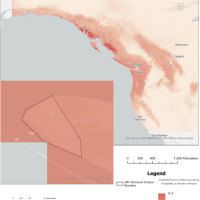 To better manage green spaces in the face of climate change, the Social Ecological Economic Development Studies program of the University of British Columbia (UBC) organized a series of projects to predict the climate suitability of common tree species at Vancouver campus by 2100. Coniferous trees are vulnerable to changing precipitation and temperature. Western hemlock (Tsuga heterophylla) is a common coniferous tree species at UBC Vancouver campus and was chosen to be analyzed in this study. Climate suitability analysis was done using a MaxEnt model. As a machine-learning algorithm not requiring data about absent points, MaxEnt is considered to be a good tool for predicting the distribution of species. There were 19 bioclimatic variables tested in the analysis, and the precipitation in the coldest quarter of the year was determined to be the most important climatic variable affecting the growth of Western hemlock. The results showed that the occurrence probability of Western hemlock would drop from its current ~87% to ~10% under one of the most likely climate models in 2100. Although this result could not represent the real occurrence probability of Western hemlock by the end of the century due to the limited data and variables considered, this study provided a reference for future climate suitability analysis for other tree species and could potentially help with the protection of existing Western hemlock on campus.
To better manage green spaces in the face of climate change, the Social Ecological Economic Development Studies program of the University of British Columbia (UBC) organized a series of projects to predict the climate suitability of common tree species at Vancouver campus by 2100. Coniferous trees are vulnerable to changing precipitation and temperature. Western hemlock (Tsuga heterophylla) is a common coniferous tree species at UBC Vancouver campus and was chosen to be analyzed in this study. Climate suitability analysis was done using a MaxEnt model. As a machine-learning algorithm not requiring data about absent points, MaxEnt is considered to be a good tool for predicting the distribution of species. There were 19 bioclimatic variables tested in the analysis, and the precipitation in the coldest quarter of the year was determined to be the most important climatic variable affecting the growth of Western hemlock. The results showed that the occurrence probability of Western hemlock would drop from its current ~87% to ~10% under one of the most likely climate models in 2100. Although this result could not represent the real occurrence probability of Western hemlock by the end of the century due to the limited data and variables considered, this study provided a reference for future climate suitability analysis for other tree species and could potentially help with the protection of existing Western hemlock on campus.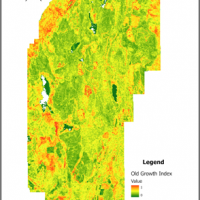 Old-growth forests have complex structures that provide critical habitat for endangered species and enhance biodiversity and ecosystem services. Old-growth forests have become rare due to harvesting. In order to support the recovery process of old-growth forests in British Columbia, it is valuable to identify old-growth characteristics in recovering forests for conservation purposes. This study attempted to predict the distribution of old-growth attributes in the Coastal Western Hemlock (CWH) zone in British Columbia using area-based LiDAR metrics. LiDAR point clouds of 61 forestry inventory plots were extracted to generate LiDAR metrics to create multilinear regression models for four old-growth attributes: standard deviation of diameter at breast height (DBH), maximum tree DBH, average live crown percentage, and the sum of understory plants percentage. The results showed the ability of LiDAR to predict varied by old-growth attributes and were highest for the standard deviation of DBH, followed by Maximum Tree DBH, the Sum of understory plants percentage and lowest for average live crown percentage. An old-growth index was derived from four old-growth attributes for mapping the potential locations of old-growth. However, the validation results of 19.08% from vegetation resource inventory (VRI) illustrate that the old-growth index does not successfully identify old growth. Despite the challenges, the prediction results can still be used to identify old-growth attributes and enhance knowledge of old-growth landscapes. Also, this study has potential applications in old-growth forest restoration and supports government’s old-growth management plans.
Old-growth forests have complex structures that provide critical habitat for endangered species and enhance biodiversity and ecosystem services. Old-growth forests have become rare due to harvesting. In order to support the recovery process of old-growth forests in British Columbia, it is valuable to identify old-growth characteristics in recovering forests for conservation purposes. This study attempted to predict the distribution of old-growth attributes in the Coastal Western Hemlock (CWH) zone in British Columbia using area-based LiDAR metrics. LiDAR point clouds of 61 forestry inventory plots were extracted to generate LiDAR metrics to create multilinear regression models for four old-growth attributes: standard deviation of diameter at breast height (DBH), maximum tree DBH, average live crown percentage, and the sum of understory plants percentage. The results showed the ability of LiDAR to predict varied by old-growth attributes and were highest for the standard deviation of DBH, followed by Maximum Tree DBH, the Sum of understory plants percentage and lowest for average live crown percentage. An old-growth index was derived from four old-growth attributes for mapping the potential locations of old-growth. However, the validation results of 19.08% from vegetation resource inventory (VRI) illustrate that the old-growth index does not successfully identify old growth. Despite the challenges, the prediction results can still be used to identify old-growth attributes and enhance knowledge of old-growth landscapes. Also, this study has potential applications in old-growth forest restoration and supports government’s old-growth management plans.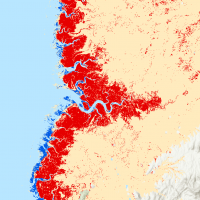 In response to the growing concerns about mangrove deforestation, recent studies have used various remote sensing technology to measure the mangrove extent. In this work, we investigated the mangrove distribution in Northwestern Madagascar by using fine spatial imagery with a pixel size as small as 3m and compared it with the result of the traditional method based on relatively coarser Landsat data. The quantitative result central to this work is the new multi-date map of the Tsimipaika- Ampasindava-Ambaro Bays (TAB) from 2020 to 2022, which provides advanced detail and direct comparison with the shift in local mangrove species. The classification maps are based on Random Forest and Maximum Likelihood algorithms, and all of them have an overall accuracy of over 85%. The dynamics of mangrove forests from 2020 to 2022 are quantified, with a 12.6% loss in closed-canopy mangroves, and a 24.1% loss in open-canopy mangroves. Limitations regarding the classification model include the overestimation of open canopy mangroves caused by the shadow and the seamline in the base map. This result shows the potential of using fine-resolution satellite imagery in supervised land cover classification, and the corresponding challenges raised by the smaller pixel size.
In response to the growing concerns about mangrove deforestation, recent studies have used various remote sensing technology to measure the mangrove extent. In this work, we investigated the mangrove distribution in Northwestern Madagascar by using fine spatial imagery with a pixel size as small as 3m and compared it with the result of the traditional method based on relatively coarser Landsat data. The quantitative result central to this work is the new multi-date map of the Tsimipaika- Ampasindava-Ambaro Bays (TAB) from 2020 to 2022, which provides advanced detail and direct comparison with the shift in local mangrove species. The classification maps are based on Random Forest and Maximum Likelihood algorithms, and all of them have an overall accuracy of over 85%. The dynamics of mangrove forests from 2020 to 2022 are quantified, with a 12.6% loss in closed-canopy mangroves, and a 24.1% loss in open-canopy mangroves. Limitations regarding the classification model include the overestimation of open canopy mangroves caused by the shadow and the seamline in the base map. This result shows the potential of using fine-resolution satellite imagery in supervised land cover classification, and the corresponding challenges raised by the smaller pixel size.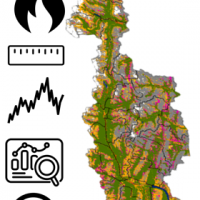 The landscapes in the Rocky Mountain Cordillera undergo constant change due to the intricate interplay of ecological processes, with fire being the primary disturbance agent. Fire suppression policies have impeded the ecological role of fire, resulting in increased conifer forest dominance and declines in landscape heterogeneity. The objective of this study was to develop a methodology to accurately measure regional landscape changes resulting from fire suppression and fire restoration in Banff National Park, with the goal of supporting data-informed resource management. A landscape metrics approach was selected to investigate changes across 27 management units. Four landscape metrics were calculated using annual land cover maps derived from Virtual Land Cover Engine/Landsat-5/7 imagery spanning 34 years (1984-2019). Metrics were selected to capture conifer encroachment (proportion of conifer class) and landscape heterogeneity (contagion, edge density, Shannon’s diversity index) changes. Time-series analysis and Thiel-Sen slope estimation were used to identify metric trends. The study’s resulting metrics offer resource managers additional landscape attributes to compare and monitor management units, which can support decision-making, prioritize fire restoration and inform future ecological studies.
The landscapes in the Rocky Mountain Cordillera undergo constant change due to the intricate interplay of ecological processes, with fire being the primary disturbance agent. Fire suppression policies have impeded the ecological role of fire, resulting in increased conifer forest dominance and declines in landscape heterogeneity. The objective of this study was to develop a methodology to accurately measure regional landscape changes resulting from fire suppression and fire restoration in Banff National Park, with the goal of supporting data-informed resource management. A landscape metrics approach was selected to investigate changes across 27 management units. Four landscape metrics were calculated using annual land cover maps derived from Virtual Land Cover Engine/Landsat-5/7 imagery spanning 34 years (1984-2019). Metrics were selected to capture conifer encroachment (proportion of conifer class) and landscape heterogeneity (contagion, edge density, Shannon’s diversity index) changes. Time-series analysis and Thiel-Sen slope estimation were used to identify metric trends. The study’s resulting metrics offer resource managers additional landscape attributes to compare and monitor management units, which can support decision-making, prioritize fire restoration and inform future ecological studies.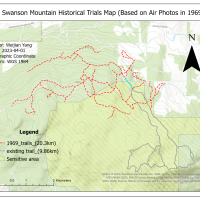 In response to growing concerns about the limited accessibility and preservation of historical trails at Rose Swanson Mountain, this study uses aerial photos and GIS to digitize these trails. Our goal is to create a comprehensive and accurate digital map of the trails while examining the impact of logging and forest fires on their length and location. The results indicate that the total length of the trails in Rose Swanson Mountain has significantly decreased due to logging activities and regulations set by the BC Ministry of Forestry. Additionally, we found that most of the existing trails are located within a sensitive area. Our study also highlighted the limitations of using aerial photography for digitizing historical trails, including the difficulty of identifying trails from air photos and the accuracy of the georeferencing process. The digital map of the historical trails can significantly contribute to the preservation of local indigenous culture and promote sustainable forest management practices that consider both economic benefits and ecological benefits. Our findings can guide policymakers in assessing the impact of logging on forests near Canadian indigenous traditional community areas and implementing regulations to mitigate these effects. Future studies can explore the benefits of preserving the forest and historical trails, such as the forest’s carbon storage potential and the economic contribution of the trail system to the local economy.
In response to growing concerns about the limited accessibility and preservation of historical trails at Rose Swanson Mountain, this study uses aerial photos and GIS to digitize these trails. Our goal is to create a comprehensive and accurate digital map of the trails while examining the impact of logging and forest fires on their length and location. The results indicate that the total length of the trails in Rose Swanson Mountain has significantly decreased due to logging activities and regulations set by the BC Ministry of Forestry. Additionally, we found that most of the existing trails are located within a sensitive area. Our study also highlighted the limitations of using aerial photography for digitizing historical trails, including the difficulty of identifying trails from air photos and the accuracy of the georeferencing process. The digital map of the historical trails can significantly contribute to the preservation of local indigenous culture and promote sustainable forest management practices that consider both economic benefits and ecological benefits. Our findings can guide policymakers in assessing the impact of logging on forests near Canadian indigenous traditional community areas and implementing regulations to mitigate these effects. Future studies can explore the benefits of preserving the forest and historical trails, such as the forest’s carbon storage potential and the economic contribution of the trail system to the local economy.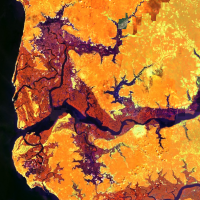 Mangrove forests are highly productive, complex coastal ecosystems that shelter a diverse range of species and offer important ecological services. In recent decades, mangrove forests in Africa have been experiencing drastic degradation and decline in population due to heavy anthropogenic pressures and climate change-induced sea level rise. To ensure the future long-term well-being of these unique ecosystems, and to reflect past conservation efforts, quantitative analysis of the past and current mangrove forest condition on a regional scale is much needed. This study systematically mapped mangrove forests along the Lower Casamance River region, using Google Earth Engine Mangrove Mapping Methodology (GEEMMM), for the years 1990 and 2021. Overall, we achieve a validation accuracy of 87.13% for the 2021 classification and 90.25% for the 1990 classification. Our study found that, across our study regions, there was a net loss of 123.99 km2 in our open-canopy mangrove I class and a net gain of 63.04 km2 in our closed-canopy mangrove class. This suggested that while some areas had seen a slight increase in mangrove populations either due to natural regeneration or ongoing conservation efforts, the overall mangrove forests had experienced major degradation. Furthermore, the majority of the loss happened within 10km of the shoreline, suggesting that fishing activity might be one of the biggest contributors to mangrove forest loss.
Mangrove forests are highly productive, complex coastal ecosystems that shelter a diverse range of species and offer important ecological services. In recent decades, mangrove forests in Africa have been experiencing drastic degradation and decline in population due to heavy anthropogenic pressures and climate change-induced sea level rise. To ensure the future long-term well-being of these unique ecosystems, and to reflect past conservation efforts, quantitative analysis of the past and current mangrove forest condition on a regional scale is much needed. This study systematically mapped mangrove forests along the Lower Casamance River region, using Google Earth Engine Mangrove Mapping Methodology (GEEMMM), for the years 1990 and 2021. Overall, we achieve a validation accuracy of 87.13% for the 2021 classification and 90.25% for the 1990 classification. Our study found that, across our study regions, there was a net loss of 123.99 km2 in our open-canopy mangrove I class and a net gain of 63.04 km2 in our closed-canopy mangrove class. This suggested that while some areas had seen a slight increase in mangrove populations either due to natural regeneration or ongoing conservation efforts, the overall mangrove forests had experienced major degradation. Furthermore, the majority of the loss happened within 10km of the shoreline, suggesting that fishing activity might be one of the biggest contributors to mangrove forest loss.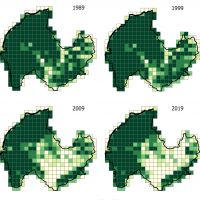 Provincial parks of British Columbia are protected for their high ecological, cultural, and recreational values. With climate change exacerbating, more frequent and severe disturbances are anticipated to cause land cover alteration in park ecosystems, leading to loss of habitat and ecosystem services. It’s crucial to understand how landscape configurations changed in the past to make informed conservation efforts. Using the landscapemetrics package in R, this project quantitatively analyzed the landscape configuration of forests and shrubs on 1 km by 1 km grids in a time step of decades from 1989 to 2019 for E. C. Manning Park, Mount Robson Park, Tweedsmuir Park, and West Arm Park. The metrics were tested to compare and characterize grids along the park boundary versus the interior. The metrics highlighted the spatial distribution and shape complexity of forests and shrubs and the time frames during which noticeable land cover changes occurred. The results provided spatial, temporal, and statistical insight into landscape dynamics over the decades. They showed that future park management could benefit from accounting for the spatial variation of the park landscape by developing targeted restoration strategies.
Provincial parks of British Columbia are protected for their high ecological, cultural, and recreational values. With climate change exacerbating, more frequent and severe disturbances are anticipated to cause land cover alteration in park ecosystems, leading to loss of habitat and ecosystem services. It’s crucial to understand how landscape configurations changed in the past to make informed conservation efforts. Using the landscapemetrics package in R, this project quantitatively analyzed the landscape configuration of forests and shrubs on 1 km by 1 km grids in a time step of decades from 1989 to 2019 for E. C. Manning Park, Mount Robson Park, Tweedsmuir Park, and West Arm Park. The metrics were tested to compare and characterize grids along the park boundary versus the interior. The metrics highlighted the spatial distribution and shape complexity of forests and shrubs and the time frames during which noticeable land cover changes occurred. The results provided spatial, temporal, and statistical insight into landscape dynamics over the decades. They showed that future park management could benefit from accounting for the spatial variation of the park landscape by developing targeted restoration strategies.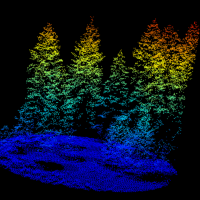 Livestock forage availability is an important factor when allocating land for grazing animals. Due to the variation in British Columbia’s topography and plant communities, rangeland management faces unique challenges with natural resource operations and rural development. The goal of this study was to create a predictive model of forage availability using light detection and ranging (LiDAR) data from the Open LiDAR Data Portal and biometric ground truthing data from the Vegetation Resource Index.
Livestock forage availability is an important factor when allocating land for grazing animals. Due to the variation in British Columbia’s topography and plant communities, rangeland management faces unique challenges with natural resource operations and rural development. The goal of this study was to create a predictive model of forage availability using light detection and ranging (LiDAR) data from the Open LiDAR Data Portal and biometric ground truthing data from the Vegetation Resource Index.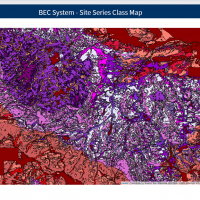 Biogeoclimatic Ecosystem Classification (BEC) system is the ecosystem classification adopted in the forest management within British Columbia based on vegetation, soil, and climate characteristics whereas Site Series is the smallest unit of the system. The Ministry of Forests, Lands, Natural Resource Operations and Rural Development held under the Government of British Columbia (“the Ministry”) developed a web-based tool known as BEC Map for maintaining and sharing the information of the BEC system, but the Site Series information was not included in the tool due to its quantity and complexity. In order to allow users to explore and interact with the information, this project aimed to develop a web-based tool with high data quality and flexibility to users for the Site Series classes using the “Shiny” and “Leaflet” packages in R.
Biogeoclimatic Ecosystem Classification (BEC) system is the ecosystem classification adopted in the forest management within British Columbia based on vegetation, soil, and climate characteristics whereas Site Series is the smallest unit of the system. The Ministry of Forests, Lands, Natural Resource Operations and Rural Development held under the Government of British Columbia (“the Ministry”) developed a web-based tool known as BEC Map for maintaining and sharing the information of the BEC system, but the Site Series information was not included in the tool due to its quantity and complexity. In order to allow users to explore and interact with the information, this project aimed to develop a web-based tool with high data quality and flexibility to users for the Site Series classes using the “Shiny” and “Leaflet” packages in R.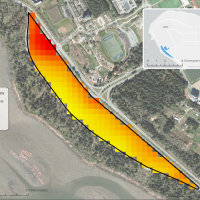 Climate change is a key factor in how extreme weather events affect how ecosystems and species react to these changes in temperatures. University of British Columbia’s (UBC) Botanical Garden is interested in improving microclimate information within the garden to understand how areas with shade create respite zones for species. Due to the recent extreme weather temperatures in Vancouver, the garden is interested in how to continue to adapt and mitigate to these extremes. Microclimates are important as they are cooler temperatures beneath the canopy. Looking at how canopy cover influences land surface temperature can give insight on microclimates. Using LiDAR metrics to calculate canopy cover and Landsat to calculate land surface temperature, a model was built to understand the significance of canopy cover and land surface temperature, with the addition of other LiDAR metrics.
Climate change is a key factor in how extreme weather events affect how ecosystems and species react to these changes in temperatures. University of British Columbia’s (UBC) Botanical Garden is interested in improving microclimate information within the garden to understand how areas with shade create respite zones for species. Due to the recent extreme weather temperatures in Vancouver, the garden is interested in how to continue to adapt and mitigate to these extremes. Microclimates are important as they are cooler temperatures beneath the canopy. Looking at how canopy cover influences land surface temperature can give insight on microclimates. Using LiDAR metrics to calculate canopy cover and Landsat to calculate land surface temperature, a model was built to understand the significance of canopy cover and land surface temperature, with the addition of other LiDAR metrics. Urban trees play an essential role in alleviating the local effects of global warming by sequestering atmospheric carbon dioxide, regulating temperature and reducing air pollution in urban areas. There have been studies estimating carbon sequestration of urban trees using Light Detection and Ranging (LiDAR). Yet, neither of the studies made comparison between species nor extended the discussion towards ecosystem services. Therefore, this study compared the attributes between native and cultivated trees in the Asian Garden of the University of British Columbia (UBC) Botanical Garden, estimated their level of above-ground carbon sequestration, and thus examined respective implications in terms of ecosystem services.
Urban trees play an essential role in alleviating the local effects of global warming by sequestering atmospheric carbon dioxide, regulating temperature and reducing air pollution in urban areas. There have been studies estimating carbon sequestration of urban trees using Light Detection and Ranging (LiDAR). Yet, neither of the studies made comparison between species nor extended the discussion towards ecosystem services. Therefore, this study compared the attributes between native and cultivated trees in the Asian Garden of the University of British Columbia (UBC) Botanical Garden, estimated their level of above-ground carbon sequestration, and thus examined respective implications in terms of ecosystem services.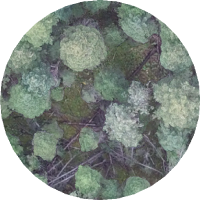 Snags (dead standing trees) form an important structural aspect of a forest and perform many essential ecological functions such as habitat provision. As such, substantial research has investigated various methods of snag detection using lidar. One approach is to compute areal lidar metrics such as slope, elevation, canopy height, etc. to detect snags. However, it remains unclear which lidar metrics are best suited for snag detection. This study attempted to predict snag presence/absence and density in the Interior Douglas-Fir (IDF) zone in British Columbia using area based lidar metrics.
Snags (dead standing trees) form an important structural aspect of a forest and perform many essential ecological functions such as habitat provision. As such, substantial research has investigated various methods of snag detection using lidar. One approach is to compute areal lidar metrics such as slope, elevation, canopy height, etc. to detect snags. However, it remains unclear which lidar metrics are best suited for snag detection. This study attempted to predict snag presence/absence and density in the Interior Douglas-Fir (IDF) zone in British Columbia using area based lidar metrics.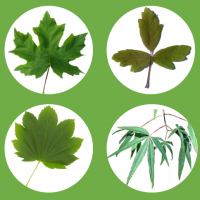 As anthropogenic climate change continues to disrupt forests and species’ ecological niches, there is increasing urgency to create plans surrounding adaptation and mitigation for especially vulnerable species. The University of British Columbia’s Botanical Garden (UBCBG) wants to understand species responses to climate change and whether species within their collection will be able to survive in the Garden, given the effects of climate change. One especially important collection UBCBG curates is maple (Acer) trees, currently leading the global consortium of Acer and housing over 50 different species. This study examined the survival probability of four Acer species UBCBG curates including: five-fingered Maple (Acer pentaphyllum Diels), considered critically endangered; paperbark/bloodbark Maple (Acer griseum (Franch.) Pax), considered endangered; bigleaf maple (Acer macrophyllum Pursh), not endangered; and vine maple (Acer circinatum Pursh), not endangered.
As anthropogenic climate change continues to disrupt forests and species’ ecological niches, there is increasing urgency to create plans surrounding adaptation and mitigation for especially vulnerable species. The University of British Columbia’s Botanical Garden (UBCBG) wants to understand species responses to climate change and whether species within their collection will be able to survive in the Garden, given the effects of climate change. One especially important collection UBCBG curates is maple (Acer) trees, currently leading the global consortium of Acer and housing over 50 different species. This study examined the survival probability of four Acer species UBCBG curates including: five-fingered Maple (Acer pentaphyllum Diels), considered critically endangered; paperbark/bloodbark Maple (Acer griseum (Franch.) Pax), considered endangered; bigleaf maple (Acer macrophyllum Pursh), not endangered; and vine maple (Acer circinatum Pursh), not endangered.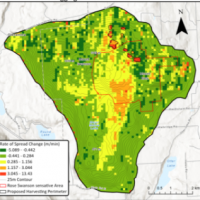 It has been long known that wildfire and harvesting can have a relationship. However, this relationship is not straightforward and well understood. In this paper, we hope to quantify the impact of proposed harvesting on the wildfire severity and probability on Rose Swanson Mountain. Rose Swanson Mountain is a small mountain in South Central BC near the town of Armstrong used by the locals for its bountiful outdoor recreation. In early 2020 British Columbia Timber Sales added part of the Rose Swanson Mountain Sensitive Area to its list of soon-to-be harvested areas. This paper illustrates the research done in BurnP3 and ArcPro to simulate and measure fire in a pre and post logged Rose Swanson.
It has been long known that wildfire and harvesting can have a relationship. However, this relationship is not straightforward and well understood. In this paper, we hope to quantify the impact of proposed harvesting on the wildfire severity and probability on Rose Swanson Mountain. Rose Swanson Mountain is a small mountain in South Central BC near the town of Armstrong used by the locals for its bountiful outdoor recreation. In early 2020 British Columbia Timber Sales added part of the Rose Swanson Mountain Sensitive Area to its list of soon-to-be harvested areas. This paper illustrates the research done in BurnP3 and ArcPro to simulate and measure fire in a pre and post logged Rose Swanson.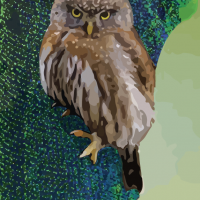 Standing dead trees (snags) are crucial habitats for fauna in mature and diverse forests along the Interior Douglas-fir Zone of British Columbia. The objective of this study is to evaluate whether snag density and snag metrics differ between three categories of at-risk and irreplaceable Old Growth Priority Deferral Areas (ancient, big-treed and remnant) and their neighbouring areas with no deferral status. Using airborne LiDAR data, we detect snags using 1) area-based forest metrics paired with random forest modelling, and 2) an individual snag detection algorithm.
Standing dead trees (snags) are crucial habitats for fauna in mature and diverse forests along the Interior Douglas-fir Zone of British Columbia. The objective of this study is to evaluate whether snag density and snag metrics differ between three categories of at-risk and irreplaceable Old Growth Priority Deferral Areas (ancient, big-treed and remnant) and their neighbouring areas with no deferral status. Using airborne LiDAR data, we detect snags using 1) area-based forest metrics paired with random forest modelling, and 2) an individual snag detection algorithm.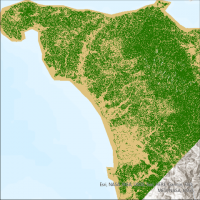 Tropical forests experience some of the highest rates of deforestation in the world. Accurate mapping and monitoring of the forest is required to mitigate this deforestation, which is complicated in tropical forests due to the high frequency of cloud cover. Synthetic aperture radar (SAR) imagery can overcome this challenge by seeing through the clouds. However, the historical lack of freely available SAR imagery means its role in characterizing forest cover is less developed than that of optical imagery. This study aimed to compare freely available SAR imagery with freely available optical imagery in order to characterize the forest cover of a particularly cloudy, mountainous tropical forest in the Philippines.
Tropical forests experience some of the highest rates of deforestation in the world. Accurate mapping and monitoring of the forest is required to mitigate this deforestation, which is complicated in tropical forests due to the high frequency of cloud cover. Synthetic aperture radar (SAR) imagery can overcome this challenge by seeing through the clouds. However, the historical lack of freely available SAR imagery means its role in characterizing forest cover is less developed than that of optical imagery. This study aimed to compare freely available SAR imagery with freely available optical imagery in order to characterize the forest cover of a particularly cloudy, mountainous tropical forest in the Philippines. In recent years, the application of remote sensing technology in vegetation change monitoring has played an important role. The purpose of this project is to explore changes in vegetation in the Tumbler Ridge region of British Columbia between the 1940s and 2020 and to discuss the relationship to fire urbanization and deforestation. A series of aerial photographs (taken in the 1940s), Landsat 5 remote sensing images (1985), and forest vegetation composite polygons (2020) were classified and analyzed by Object-Based Image Analysis (OBIA) and Support Vector Machines (SVM) for evaluation Vegetation Composition and Matrix Analysis of Vegetation Change in the Tumbler Ridge Region Using Vegetation Transition Matrix.
In recent years, the application of remote sensing technology in vegetation change monitoring has played an important role. The purpose of this project is to explore changes in vegetation in the Tumbler Ridge region of British Columbia between the 1940s and 2020 and to discuss the relationship to fire urbanization and deforestation. A series of aerial photographs (taken in the 1940s), Landsat 5 remote sensing images (1985), and forest vegetation composite polygons (2020) were classified and analyzed by Object-Based Image Analysis (OBIA) and Support Vector Machines (SVM) for evaluation Vegetation Composition and Matrix Analysis of Vegetation Change in the Tumbler Ridge Region Using Vegetation Transition Matrix.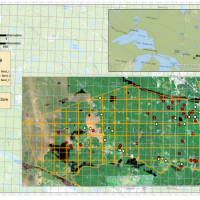 Traditionally, Light Detection and Ranging (LiDAR) was used for forest structure analysis rather than capturing spectral information. A variety of studies were conducted to investigate the spectral characteristics of multispectral LiDAR but relatively few ones have integrated it with Landsat imageries. To compare their recorded reflectance and explore the prediction potential, we evaluated two series of regression modules measuring forest reflected energy with Landsat-derived reflectance and multispectral LiDAR-derived intensity, collected over 85 plots with the same area of 1000 m2 in Petawawa Research Forest, Ontario.
Traditionally, Light Detection and Ranging (LiDAR) was used for forest structure analysis rather than capturing spectral information. A variety of studies were conducted to investigate the spectral characteristics of multispectral LiDAR but relatively few ones have integrated it with Landsat imageries. To compare their recorded reflectance and explore the prediction potential, we evaluated two series of regression modules measuring forest reflected energy with Landsat-derived reflectance and multispectral LiDAR-derived intensity, collected over 85 plots with the same area of 1000 m2 in Petawawa Research Forest, Ontario.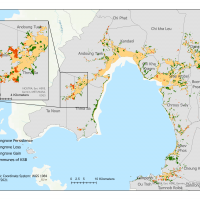 Mangrove forests are productive and biologically complex ecosystems that provide a wide range of environmental services and supply people with numerous goods. Growing in a variety of depths of salty water, mangrove forests play a significant role in supporting the coastal communities along Cambodia’s 440 kilometer-long coastline. However, mangrove forests in Cambodia have experienced great losses due to the impacts of intensive human activities. Although the human-driven mangrove losses in Cambodia have declined, the recent coverage change of mangrove forests needs to be evaluated for implementing effective regional ecological restoration programs.
Mangrove forests are productive and biologically complex ecosystems that provide a wide range of environmental services and supply people with numerous goods. Growing in a variety of depths of salty water, mangrove forests play a significant role in supporting the coastal communities along Cambodia’s 440 kilometer-long coastline. However, mangrove forests in Cambodia have experienced great losses due to the impacts of intensive human activities. Although the human-driven mangrove losses in Cambodia have declined, the recent coverage change of mangrove forests needs to be evaluated for implementing effective regional ecological restoration programs.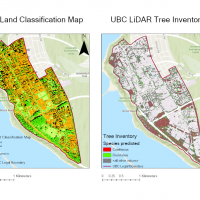 As urban forest provides ecological, social, and economic values to the residents, forest inventory can monitor forest health. Based on the land classification map, the campus planning team pays attention to tree health in the public green space of the University of British Columbia (UBC) campus in Vancouver, Canada. Working together, the forest inventory and land classification map are the priorities of urban planning and forest health in UBC. In order to solve the knowledge gap of no current inventory and land classification map on campus, this study aimed to update the UBC tree inventory and land classification map.
As urban forest provides ecological, social, and economic values to the residents, forest inventory can monitor forest health. Based on the land classification map, the campus planning team pays attention to tree health in the public green space of the University of British Columbia (UBC) campus in Vancouver, Canada. Working together, the forest inventory and land classification map are the priorities of urban planning and forest health in UBC. In order to solve the knowledge gap of no current inventory and land classification map on campus, this study aimed to update the UBC tree inventory and land classification map.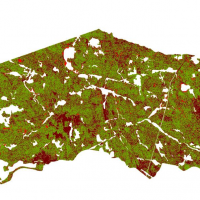 Monitoring the growth of trees is important for sustainable forest management. The traditional method of monitoring forest growth at a broad level is timber cruising by humans, while modern remote sensing technology, especially Lidar, is usually used for monitoring at the single-tree level or stand-level.
Monitoring the growth of trees is important for sustainable forest management. The traditional method of monitoring forest growth at a broad level is timber cruising by humans, while modern remote sensing technology, especially Lidar, is usually used for monitoring at the single-tree level or stand-level.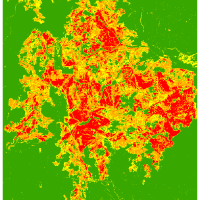 Understanding how resilient forests are after wildfire events is important to forest management practices. The objective of this study was to use Landsat-8 data to understand how the burn severity of the Little Bobtail Lake wildfire has impacted forest regrowth several years later. This was done by deriving different vegetation indices to see how the changes in vegetation health were impacted by burn severity. Additionally, landscape pattern metrics were used to understand the changes in the spatial patterns of the burn severity and vegetation health over time.
Understanding how resilient forests are after wildfire events is important to forest management practices. The objective of this study was to use Landsat-8 data to understand how the burn severity of the Little Bobtail Lake wildfire has impacted forest regrowth several years later. This was done by deriving different vegetation indices to see how the changes in vegetation health were impacted by burn severity. Additionally, landscape pattern metrics were used to understand the changes in the spatial patterns of the burn severity and vegetation health over time.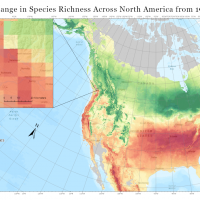 Climate change poses a considerable risk to forest diversity in urban communities. The University of British Columbia (UBC) seeks to identify vulnerable tree species on campus and apply strategies for sustaining arboreal diversity in future decades. In contribution to these efforts, this study investigated the potential shift in tree composition on the UBC Vancouver Campus over the next century by (1) predicting suitable climatic habitat for 128 campus species in 2050 and 2080, and (2) mapping the expected change in species richness across North America.
Climate change poses a considerable risk to forest diversity in urban communities. The University of British Columbia (UBC) seeks to identify vulnerable tree species on campus and apply strategies for sustaining arboreal diversity in future decades. In contribution to these efforts, this study investigated the potential shift in tree composition on the UBC Vancouver Campus over the next century by (1) predicting suitable climatic habitat for 128 campus species in 2050 and 2080, and (2) mapping the expected change in species richness across North America.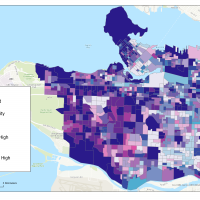 Urban vegetation acts as an extremely important carbon stock to store carbon. Although many studies have investigated the relationship between urban vegetation and carbon stocks, few of them closely examine the phenomenon of vegetation fragmentation in urban areas and how it affects the carbon stock. Therefore, this project investigates how vegetation fragmentation affects carbon stocks in the City of Vancouver using GIS analytic tools.
Urban vegetation acts as an extremely important carbon stock to store carbon. Although many studies have investigated the relationship between urban vegetation and carbon stocks, few of them closely examine the phenomenon of vegetation fragmentation in urban areas and how it affects the carbon stock. Therefore, this project investigates how vegetation fragmentation affects carbon stocks in the City of Vancouver using GIS analytic tools.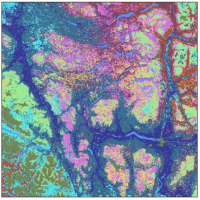 Geospatial analyses focused on quantifying fuel types fragmentation and its autocorrelation with megafire severity inform decision making in contexts such as forest management and human activities regulation. Fuel type fragmentation plays a crucial role in fire severity contribution.
Geospatial analyses focused on quantifying fuel types fragmentation and its autocorrelation with megafire severity inform decision making in contexts such as forest management and human activities regulation. Fuel type fragmentation plays a crucial role in fire severity contribution.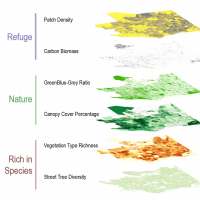 Living in cities can be stressful. While studies have shown that exposure to nature can help reduce stress and promote mental wellbeing, some research has shown that some characteristics of nature provide more psychological support than others depending on one’s state of wellbeing. City planning and urban forestry strategy need to consider the qualitative attributes of urban nature in the landscape in order to better support the different needs of the residents. This study focused on restorative nature: nature elements that help relieve stress and alleviate mental fatigue.
Living in cities can be stressful. While studies have shown that exposure to nature can help reduce stress and promote mental wellbeing, some research has shown that some characteristics of nature provide more psychological support than others depending on one’s state of wellbeing. City planning and urban forestry strategy need to consider the qualitative attributes of urban nature in the landscape in order to better support the different needs of the residents. This study focused on restorative nature: nature elements that help relieve stress and alleviate mental fatigue.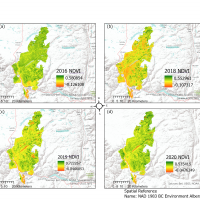 The 2017 Elephant Hill wildfire is considered as one of the most destructive fires in Canada. Wildfires are a major ecosystem disturbance which also causes residential displacement and financial loss. Monitoring vegetation recovery following wildfires becomes crucial to rebuilding the local community and ecological system.
The 2017 Elephant Hill wildfire is considered as one of the most destructive fires in Canada. Wildfires are a major ecosystem disturbance which also causes residential displacement and financial loss. Monitoring vegetation recovery following wildfires becomes crucial to rebuilding the local community and ecological system.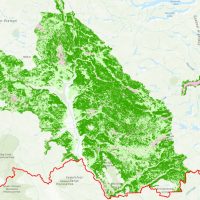 The Interior Douglas-fir zone of British Columbia’s Cariboo Region evolved alongside wildfire through millennia of repeat exposure. Resulting from these interactions were fire adapted species and landscape configurations that supported low to moderate severity wildfires. Removing the dominant disturbance agent of these dry forest ecosystems through systematic fire suppression has resulted in unforeseen repercussions. Presently, forests of the Interior Douglas-fir zone hold the potential for higher severity wildfire posing an increased threat to human life.
The Interior Douglas-fir zone of British Columbia’s Cariboo Region evolved alongside wildfire through millennia of repeat exposure. Resulting from these interactions were fire adapted species and landscape configurations that supported low to moderate severity wildfires. Removing the dominant disturbance agent of these dry forest ecosystems through systematic fire suppression has resulted in unforeseen repercussions. Presently, forests of the Interior Douglas-fir zone hold the potential for higher severity wildfire posing an increased threat to human life.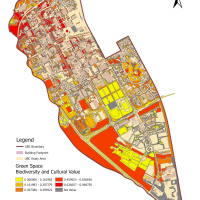 Due to the rapid growth of urbanization, species biodiversity is threatened and the innate relationship between humans and nature begins to fade gradually. Urban green spaces play a vital role in reconnecting human and urbanized landscape with its unique characteristics. Meanwhile, virtual gaming technology with applied geographic information has made a spectacular process to promote interactions between humans and their surroundings.
Due to the rapid growth of urbanization, species biodiversity is threatened and the innate relationship between humans and nature begins to fade gradually. Urban green spaces play a vital role in reconnecting human and urbanized landscape with its unique characteristics. Meanwhile, virtual gaming technology with applied geographic information has made a spectacular process to promote interactions between humans and their surroundings.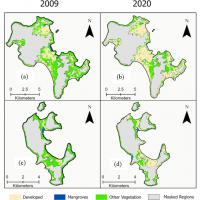 Mangrove forests, and other coastal ecosystems, are recognized for their role in climate change mitigation due to their significant potential for carbon storage and carbon sequestration. These ecosystems are some of the most threatened ecosystems on earth and are at risk of loss and degradation because of anthropogenic activities. Carbon financing mechanisms offer a way to help implement, finance and support the conservation and restoration of coastal ecosystems.
Mangrove forests, and other coastal ecosystems, are recognized for their role in climate change mitigation due to their significant potential for carbon storage and carbon sequestration. These ecosystems are some of the most threatened ecosystems on earth and are at risk of loss and degradation because of anthropogenic activities. Carbon financing mechanisms offer a way to help implement, finance and support the conservation and restoration of coastal ecosystems.